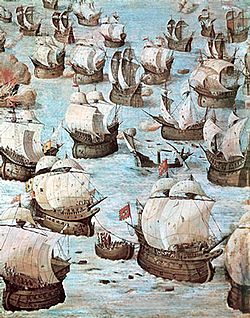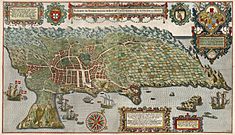Battle of Vila Franca do Campo facts for kids
Quick facts for kids Battle of Ponta Delgada |
|||||||
|---|---|---|---|---|---|---|---|
| Part of the War of the Portuguese Succession | |||||||
 Fresco by Niccolò Granello showing the Battle of Ponta Delgada in the Hall of Battles at El Escorial |
|||||||
|
|||||||
| Belligerents | |||||||
| Commanders and leaders | |||||||
| Strength | |||||||
| 28 warships | 60 warships | ||||||
| Casualties and losses | |||||||
| 224 dead, 550 wounded |
1,500 dead, 1,500 wounded, missing or captured, 7 ships missing, 4 ships sunk, 2 ships burned, 4 ships captured |
||||||
The Battle of Ponta Delgada was an important naval battle. It happened on July 26, 1582, near São Miguel Island in the Azores Islands. This battle was part of the War of the Portuguese Succession.
In this war, Spain and Portugal were fighting over who should be the next king of Portugal. A combined fleet, mostly from France and England, sailed to the Azores. They wanted to keep the islands under the control of António, who claimed to be the rightful king of Portugal. They also wanted to stop the islands from joining the Iberian Union, which was a union of Spain and Portugal under the Spanish king.
This battle was one of the first big naval fights far from the mainland. It involved large warships called carracks and galleons. The French-led fleet, commanded by Filippo di Piero Strozzi, was badly beaten by a Spanish fleet. The Spanish fleet was led by Álvaro de Bazán. This Spanish victory helped Spain take control of the Azores. It also completed Portugal's joining into the Spanish Empire.
Why the Battle Happened
The Azores Islands were the only part of Portugal's overseas empire that did not accept Philip II of Spain as their new king. Philip II was already King of Spain. He also claimed the throne of Portugal, becoming Philip I of Portugal.
The French king sent a fleet to help the Azores defend themselves. This fleet was led by a hired admiral named Filippo di Piero Strozzi.
King Philip offered to forgive the nine islands if they surrendered. But his messenger was not welcomed in Angra do Heroísmo on Terceira Island. The messenger then went to São Miguel Island, which had already sworn loyalty to King Philip.
While a Spanish fleet was getting ready in Lisbon to take the islands, a Spanish commander named Pedro Valdés was sent to the Azores. He was supposed to offer peace again. But he was told not to start fighting until a larger force was ready. However, after getting the same unfriendly response, Valdés tried to attack Terceira. This attack became known as the Battle of Salga. His 600 soldiers were attacked by wild bulls and were badly defeated. They had to flee back to their ships.
Meanwhile, António went to England to seek help. Some English leaders wanted to send an expedition to the Azores. But Elizabeth I did not want to start a war with Philip II. So, António returned to France.
The Battle Itself

In June 1582, António's French fleet left Belle Île. Their plan was to take control of São Miguel and Santa Maria islands. They also hoped to capture the Spanish treasure fleet. This fleet would likely stop in the Azores.
However, when Álvaro de Bazán learned that Strozzi had sailed, he also headed for the Azores. Bazán had fewer ships, but his ships were larger and had more powerful weapons than Strozzi's. He arrived too late to stop the French from landing on São Miguel Island. But he arrived in time to save the main city, Ponta Delgada.
After a brief fight on July 24, 1582, the two fleets met again two days later. This was a fierce battle south of São Miguel Island. The French ships first had the advantage of the wind. They attacked the back of the Spanish fleet with more ships. But this allowed Bazán, the Spanish commander, to get his ships into a better position. His lead ships then attacked the French.
The Spanish were outnumbered two to one. A large Spanish galleon, the San Mateo (or São Mateus), took the main force of the French attack. This ship was very strong and had 30 guns. Even though it was surrounded and hit by many cannonballs, its sailors fought bravely. They stopped all attacks. Then, they even managed to board and capture two French ships before the battle ended. Many French ships fled.
Álvaro de Bazán, on his flagship São Martinho, looked for Strozzi's ship. He found it in the smoke and chaos. He fired at it until it was almost sinking. By the end of the battle, António's fleet had lost 10 ships, either sunk or captured. Over 1,000 men were lost, including Strozzi. Bazán's forces defeated the French by using both cannon fire and by boarding enemy ships.
Some people thought Strozzi was unlucky to lose. His ships were faster than Bazán's. They also used their cannons well. However, the Spanish fleet also suffered a lot of damage. A painting in El Escorial's Hall of Battles shows how much damage the Spanish ships took. The galleon San Martín (São Martinho) barely managed to tow a captured enemy ship back to port.
On July 26, after five hours of fighting, the French and English fleets were defeated. Seventeen of their ships ran away. Some captured French soldiers were treated harshly. Spanish soldiers and captains asked Bazán to show mercy. But Bazán said he was following orders from the King of France. He said that since France was at peace with Spain, French subjects should not act like pirates attacking Spanish ships.
What Happened Next
The French fleet, though larger, was not strong enough to challenge the Spanish in the Atlantic. The French losses were very heavy and a major defeat.
Even though cannons were used well, the battle was mostly decided by old-style boarding of enemy ships. The Portuguese were among the first to understand how important naval cannons were. It seems Strozzi did not fully listen to the Portuguese in his fleet. They suggested using cannons more in a "line of battle" tactic. This was a new way of fighting that would become common later.
Álvaro de Bazán had won a great victory. People in Spain were very happy when he returned. The French ambassador in Spain even reported that some Spaniards were very proud of their victory.
Terceira Island remained under António's control for a while. In the spring of 1583, he got 800 more French troops to help. But Bazán now controlled the sea. He quickly prepared a huge invasion force in Lisbon. He had 15,372 men and 98 ships. These included large merchant ships used to carry troops, smaller boats, and powerful warships. This time, his goal was not to fight a fleet. It was to land an army.
The people on Terceira expected the Spanish to land at the harbors of Angra do Heroísmo. But Bazán decided to land his main force at Mole. This was a beach 10 miles from Angra. It was only defended by light earth walls and some soldiers with cannons. Bazán's report describes the landing:
"The lead ship began to fire at the enemy's cannons. Other ships did the same. The landing boats reached the shore and put soldiers on the sides of the forts and along the trenches. This was very difficult because of the strong fire from enemy cannons and guns. The soldiers climbing the trenches faced heavy fire. But they finally captured the forts and trenches."
António was on Terceira and helped prepare defenses. But he left in November to get more French help. Another 1,500 French soldiers arrived in June 1583. By then, Santa Cruz had increased his fleet to 96 ships and 9,500 men. He also had 2,000 soldiers on São Miguel Island.
Bazán offered António mercy, marriage, and money if he surrendered. But António refused. After one day of fighting, Terceira fell. French and English soldiers on the island were allowed to leave safely. But sixteen of António's supporters were executed. Dom António and a few of his supporters were lucky to escape with their lives.
Images for kids
-
Fresco by Niccolò Granello showing the Battle of Ponta Delgada in the Hall of Battles at El Escorial
-
Map of Terceira. By Jan Huygen van Linschoten
-
The Spanish Tercios landing on Terceira. El Escorial Hall of Battles
See also
 In Spanish: Batalla de la isla Terceira para niños
In Spanish: Batalla de la isla Terceira para niños




